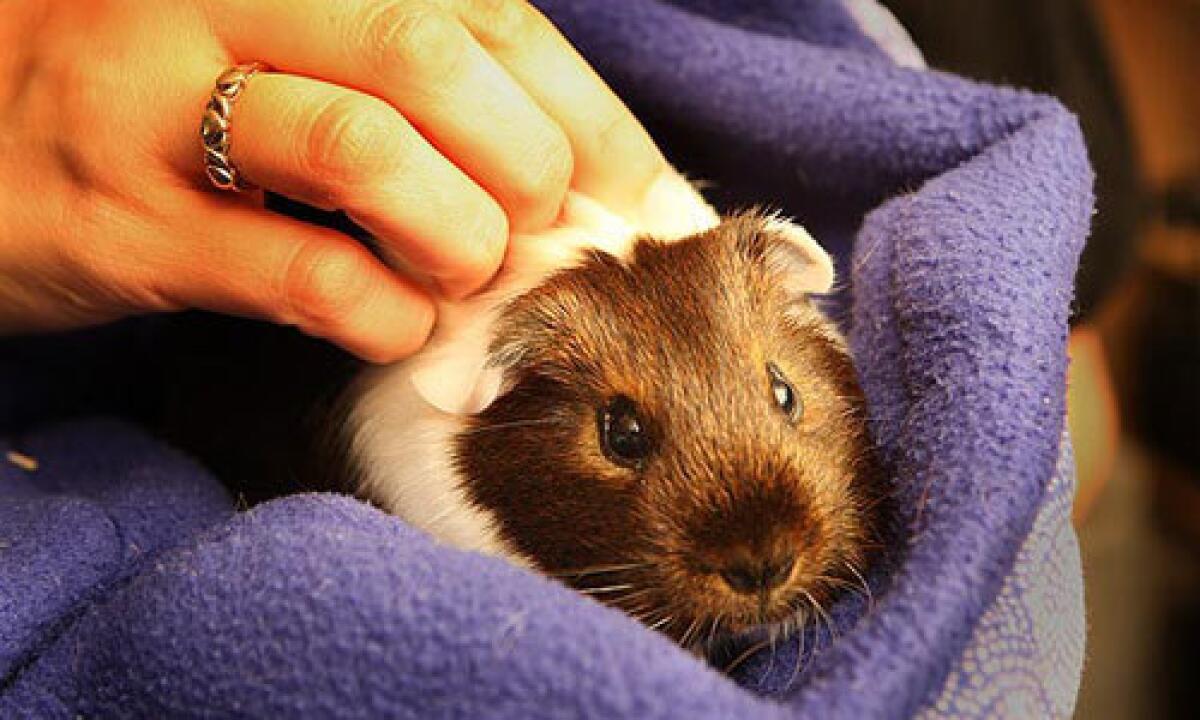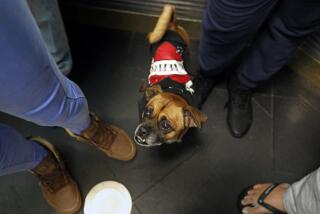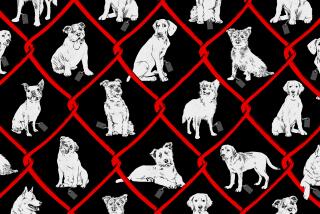Guinea pigs need shelter too

Franklin and Bart are 3-month-old brothers abandoned in a park, left to watch as their mother got run over by a car. Itchy has arthritis and requires medication to stave off kidney failure. Brad and Angelina are a bonded pair, and now that their pups are weaned and Brad has been neutered, they’re ready for a fresh start in a new, loving home.
Sure, dog and cat rescue listings have an unmistakable ring. The amusing names (Chandler and Joey, Mimosa and Margarita). The endearing habits (loves to beg for treats!). The harrowing tales of survival and triumph over adversity (left vulnerable to predators by a creek, saved from death at the animal shelter).
But those mini-biographies take on an entirely new dimension when the accompanying photos show neither a spunky Chihuahua nor a shy tabby but, rather, a Peruvian, ridgeback or Abyssinian -- all types of guinea pigs.
Nationally, no agency or organization tracks the number of rescue groups for guinea pigs, also called cavies. But talk to enough people in this movement -- and it is a movement -- and most say that their ranks are growing. After all, these critters, which are neither natives of Guinea nor pigs, need help too.
Enter the guinea pig rescuers, volunteers who, like their cat- and dog-loving brethren, pluck the palm-sized South American rodents from an uncertain future in shelters and on the streets, then provide foster homes until a permanent adoptive family can be found.
Jenn Lima, a volunteer with Orange County Cavy Haven, is fostering a mother-daughter pair of sows in her West L.A. apartment. She said her group keeps tabs on two to 10 guinea pigs in local animal shelters on any given week, pulling as many as possible for adoption. Fenella Speece, founder of Wee Companions Small Animal Adoption in San Diego, says guinea pigs outnumber the hamsters, rats, rabbits and chinchillas -- 250 in all -- in her group’s network of foster homes. The Texas Rustlers Guinea Pig Rescue outside of Dallas, Cavy Rescue New England, the Cavy Care Guinea Pig Shelter and Sanctuary in Aurora, Colo. . . .
“There’s been a real proliferation in the number of rescues around the country,” said Teresa Murphy, founder of Cavy Spirit in Redwood City, Calif. She estimated that 20 to 30 large-scale guinea pig rescue operations have been established nationwide, each with at least 50 animals in their care at any given time. Smaller rescues are expanding too, she said.
The animals are surrendered by owners, plucked from shelters, fished out of trash cans or simply abandoned in homes and yards when owners move on, said Julia Hinrichs, president of Texas Rustlers, which takes in about 20 new guinea pigs every month. Shannon Cauthen, who runs Cavy Care in Colorado, said that for every furry face that gets adopted from her shelter, a new one comes. On any given day, she has 100 guinea pigs waiting for a second chance.
Many rescuers are bracing for the numbers to grow in the months to come. Blame Disney’s summer movie “G-Force,” a kid flick featuring wise-cracking guinea pigs as FBI agents trying to save the world. Neither Petco nor PetSmart would release specific figures, but spokeswomen for both said the chains have seen rising interest in guinea pigs since the movie premiered.
That would be fine, animal protection groups say, if such film-fueled spikes in public demand weren’t usually followed by an epidemic of buyer’s remorse. Dalmatians, Chihuahuas and even clown fish (remember little Nemo?) have all been down this fickle road, said animal behaviorist Stephen L. Zawistowski, executive vice president of the American Society for the Prevention of Cruelty to Animals. Beloved one day, in the shelter the next.
“Unlike the foosball table,” Zawistowski said, “you can’t just stick it down in the basement until you want to play with it again.”
Guinea pigs poop (who doesn’t?) and sometimes have accidents when picked up. They get chubby if not exercised, can get sickened by their cedar bedding and develop scurvy if improperly fed. Such were the guinea-pig facts of life that Orange County Cavy Haven volunteer Leiana Swadish shared with families attending a recent adoption event at Centinela Feed & Pet Supplies in Costa Mesa.
Beth Romeyn, 7, was present with older sister Courtney and their parents, Marisol and Steve Romeyn. The Long Beach girl bounced with excitement and tap-tap-tapped her hands together as she gazed at an array of nose-wiggling, hay-nibbling guinea pigs.
“They’re sooo cuuute!” Beth said, and therein lies the problem. Charmed by the furry cuteness, owners sometimes underestimate the guinea pigs’ needs or overestimate their child’s ability to help with feeding, care and cage cleaning, Swadish said. Others have allergic reactions to fur, dander or the special hay and alfalfa guinea pigs chew on to keep their gnarly teeth in check.
And if you think the animals’ petite size means rescue groups exercise any less scrutiny than dog rescue groups infamously demand, think again. The guinea pig adoption application of the Small Animal Rescue Society of British Columbia contains no fewer than three pages of interrogation:
Do you rent? May we contact your landlord? Do you have children? Please describe your “perfect” guinea pig. Will you allow the animal to go outside of its cage? Why or why not? How many hours per day will the guinea pigs be without human companionship?
And so on.
“I’ve had five adoption inquiries this week, and I’ve turned down all five,” Cavy Care’s Cauthen said. “I’m looking for a lifelong commitment.”
Indeed, the animals often live five to eight years. And though parents may plunk down $35 for a guinea pig at a pet store, if an ailment strikes, Mom and Dad may be looking at $50 just for an exam with an exotic animal veterinarian. Make that $150 after tests and medication. Rescuers fear that what had been the cute new member of the family ultimately may be seen as a disposable pet.
That explains the rigor with which Murphy screens prospective adopters. Her first rule: Parents must be excited and engaged. “It can’t just be the kid,” she said. “Otherwise, six months, a year, two years into it, the guinea pigs end up back in the system again.”
Because the animals are social by nature, Murphy insists that they be adopted in pairs or groups. Cages must be at least 10 square feet, and they must be kept in a common family area, not a child’s bedroom, to emphasize that the responsibility for the animal falls to all members of the household. She has adopters visit her shelter on Saturdays, when cages are cleaned and the full reality of guinea pig ownership is exposed, and she requires adopters to sign a contract that states they will submit to a home visit to ensure rules are being followed.
Though that may not sound like a recipe for smiles and giggles, those who do bring guinea pigs home say they’re worth the effort. Zawistowski touts the fluffy rodents as good pets for families that don’t have a yard or an area to walk a dog. Guinea pigs snuggle. They can learn their names. They can “popcorn,” which is a hopping motion that gets them pretty much nowhere but is charming to watch. And they whistle.
“They go ‘wheek, wheek, wheek,’ ” said Zawistowski, who wooed his college girlfriend (now wife) with the gift of a guinea pig that she kept healthy and happy in her dorm room.
Beth Romeyn’s household is happier too. Cavy Haven took two weeks to process adoption papers, giving the Romeyns time to build a proper cage, buy supplies and make sure this wasn’t an impulse decision. Now Beth has two guinea pig pals.
“She’s very happy,” said her father. “Everybody likes them.”
After all, they are so cute.
More to Read
Sign up for Essential California
The most important California stories and recommendations in your inbox every morning.
You may occasionally receive promotional content from the Los Angeles Times.









